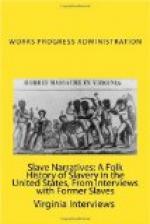Jacob Keephart, her master, was very kind to his slaves, would never sell them to “nigger traders.” His family was very large, so they bought and sold their slaves within the families and neighbors.
Mrs. Locke’s father, brothers, and grandmother belonged to the same master in Henry County, Kentucky. Her mother and the two sisters belonged to another branch of the Keephart family, about seven miles away.
Her father came to see her mother on Wednesday and Saturday nights. They would have big dinners on these nights in their cabin.
Her father cradled all the grain for the neighborhood. He was a very high tempered man and would do no work when angry; therefore, every effort was made to keep him in a good humor when the work was heavy.
Her mother died when the children were very young. Sarah was given to the Keephart daughter as a wedding present and taken to her new home. She was always treated like the others in the family.
After the abolition of slavery, Mr Keephart gave Wm. a horse and rations to last for six months, so the children would not starve.
Charles and Lydia French, fellow workers with the Taylors, went to Cincinnatti and in 1867 sent for the Mrs. Locke and her sister, so they could go to school, as there were no schools in Kentucky then. The girls stayed one year with the French family; that is the longest time they ever went to school. After that, they would go to school for three months at different times. Mrs. Locke reads and writes very well.
The master worked right along with the slaves, shearing the sheep.
The women milk ten or twelve cows and knit a whole sock in one day. They also wove the material for their dresses; it was called “linsey.”
She remembers one night the slaves were having a dance in one of the cabins, a band of Ku Kluxers came, took all firearms they could find, but no one was hurt, all wondered why, however, it did not take long for them to find out why. Another night when the Kluxers were riding, the slaves recognised the voice of their young master. That was the reason why the Keephart slaves were never molested.
Christmas was a jolly time for the Keephart slaves. They would have a whole week to celebrate, eating, dancing, and making merry.
“Free born niggers” were not allowed to associate with the slaves, as they were supposed to have no sense, and would contaminate the slaves.
Interviewer’s Comment
Mrs. Locke is an intelligent old lady, has been a good dressmaker, and served for a great number of the “first families” of Indianapolis.
She has been married twice; her first husband died shortly after their marriage, and she was a widow for twenty-five years before she took her second “venture.”
She gets the old age pension and is very happy.
Submitted December 17, 1937
Indianapolis, Indiana




